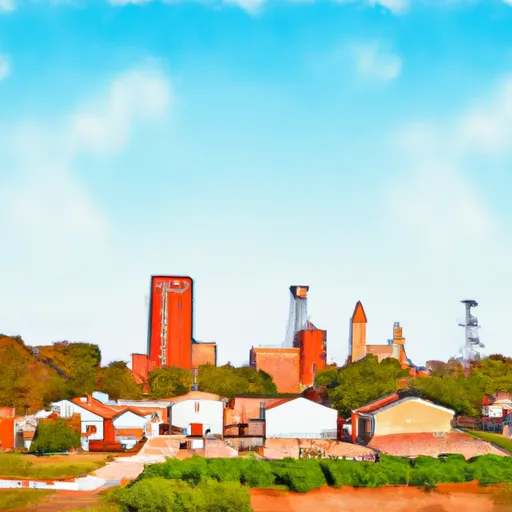-
 Snoflo Premium
Snoflo Premium
Get unlimited access to all our content
With no Ad interruptions! - Start Your Free Trial Login with existing account
Rinard
Eden Index
Climate
8.3
•
Recreation
2.8
•
Community
•
Safeguard
4.3/10

Rinard, Illinois is a small village located in Wayne County. It experiences a typical Midwestern climate, characterized by hot summers and cold winters. Summers are generally warm with temperatures ranging from the 70s to the 90s Fahrenheit, while winters can be quite cold, with temperatures dropping to the 20s and occasionally even lower.
In terms of hydrology constituents, Rinard is not situated near any major rivers or bodies of water. However, there are several smaller creeks and streams that flow through the area, contributing to local groundwater reserves.
For outdoor enthusiasts, Rinard offers a variety of recreational opportunities. The surrounding countryside provides ample space for activities such as hiking, camping, and birdwatching. Wayne Fitzgerrell State Recreation Area, located a short drive away, offers more extensive outdoor activities, including boating, fishing, and hunting. The Shawnee National Forest is also within reach, offering opportunities for camping, hiking, and exploring the scenic beauty of southern Illinois. In conclusion, while Rinard may be a small village, it provides a tranquil setting with access to outdoor recreational opportunities.
What is the Eden Index?
The Snoflo Eden Index serves as a comprehensive rating system for regions, evaluating their desirability through a holistic assessment of climate health, outdoor recreation opportunities, and natural disaster risk, acknowledging the profound impact of these factors on livability and well-being.
Climate Health Indicator (CHI): 8.3
Rinard receives approximately
1125mm of rain per year,
with humidity levels near 82%
and air temperatures averaging around
13°C.
Rinard has a plant hardyness factor of
6, meaning
plants and agriculture in this region thrive during a short period during spring and early summer. Most
plants will die off during the colder winter months.
By considering the ideal temperature range, reliable water supplies, clean air, and stable seasonal rain or snowpacks, the Climate Health Indicator (CHI) underscores the significance of a healthy climate as the foundation for quality living.
A healthy climate is paramount for ensuring a high quality of life and livability in a region, fostering both physical well-being and environmental harmony. This can be characterized by ideal temperatures, reliable access to water supplies, clean air, and consistent seasonal rain or snowpacks.
Weather Forecast
Streamflow Conditions
Wabash
Area Rivers
Wabash
Snowpack Depths
Wabash
Reservoir Storage Capacity
Wabash
Groundwater Levels
Recreational Opportunity Index (ROI): 2.8
The Recreational Opportunity Index (ROI) recognizes the value of outdoor recreational options, such as parks, hiking trails, camping sites, and fishing spots, while acknowledging that climate plays a pivotal role in ensuring the comfort and consistency of these experiences.
Access to outdoor recreational opportunities, encompassing activities such as parks, hiking, camping, and fishing, is crucial for overall well-being, and the climate plays a pivotal role in enabling and enhancing these experiences, ensuring that individuals can engage in nature-based activities comfortably and consistently.
Camping Areas
| Campground | Campsites | Reservations | Toilets | Showers | Elevation |
|---|---|---|---|---|---|
| Charley Brown City Park | None | 487 ft | |||
| Lake Tom Bailey | 32 | 299 ft | |||
| Sam Dale Lake Conservation Area | None | 493 ft | |||
| Turkey Fork Rec. Area | 76 | 278 ft | |||
| Clarkco State Park | None | 273 ft | |||
| Gibson City Park | 4 | 731 ft | |||
| Shepard State Park | None | 16 ft | |||
| Citronelle Lakeview RV Park | 24 | 226 ft | |||
| Archusa Creek Waterpark | 69 | 315 ft | |||
| Lakeview RV City Park | None | 230 ft |
Nearby Ski Areas
Catastrophe Safeguard Index (CSI):
The Catastrophe Safeguard Index (CSI) recognizes that natural disaster risk, encompassing floods, fires, hurricanes, and tornadoes, can drastically affect safety and the overall appeal of an area.
The level of natural disaster risk in a region significantly affects safety and the overall livability, with climate change amplifying these risks by potentially increasing the frequency and intensity of events like floods, fires, hurricanes, and tornadoes, thereby posing substantial challenges to community resilience and well-being.
Community Resilience Indicator (CRI):
The Community Resilience Indicator (CRI) recognizes that education, healthcare, and socioeconomics are crucial to the well-being of a region. The CRI acknowledges the profound impact of these elements on residents' overall quality of life. By evaluating educational resources, healthcare accessibility, and economic inclusivity, the index captures the essential aspects that contribute to a thriving community, fostering resident satisfaction, equity, and social cohesion.

